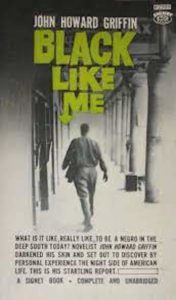
*Black Like Me, a nonfiction book by white journalist John Howard Griffin, is celebrated on this date in 1961.
It was recounting his journey in the Deep South of the United States when Blacks lived under the height of Jim Crow racial segregation. Griffin was a native of Mansfield, Texas, whose skin was temporarily darkened to pass as a Black man. He traveled for six weeks throughout the racially segregated states of Louisiana, Mississippi, Alabama, Arkansas, and Georgia to explore life from the other side of the color line.
Sepia Magazine and George Levitan financed the project in exchange for the right to print the account first as a series of articles, which it did under Journey into Shame. Griffin kept a journal of his experiences; the 188-page diary was the book's genesis. When he started his project in 1959, race relations in America were particularly strained. The book's title comes from the last line of Langston Hughes's poem "Dream Variations."
In late 1959, Griffin went to a friend's house in New Orleans, Louisiana. Under the care of a dermatologist, Griffin underwent a regimen of large oral doses of the anti-vitiligo drug methoxsalen and spent up to 15 hours daily under an ultraviolet lamp for about a week. He was given regular blood tests to ensure he was not suffering liver damage. The darkening of his skin wasn't perfect, so Griffin touched it up with a stain. He shaved his head bald to hide his straight brown hair. Satisfied he could pass as black, he began a six-week journey in the South. Don Rutledge traveled with him, documenting the experience with photos. During his trip, Griffin abided by the rule that he would not change his name or alter his identity; if asked who he was or what he was doing, he would tell the truth.
Initially, Griffin decided to talk as little as possible to ease his transition into the social environment of southern U.S. blacks. He became accustomed everywhere to the "hate stare" received from whites. After he disguised himself, many people who knew Griffin as a white man did not recognize him. Sterling Williams, a black shoeshine man in the French Quarter whom Griffin regarded as a casual friend, did not recognize him. He first hinted that he wore the same unusual shoes as somebody else, but Sterling still did not recognize him until Griffin told him. Because Griffin wanted assistance in entering the black community, he decided to tell Sterling about his identity and project. In New Orleans, a black counterman talked with Griffin about the difficulties of finding a place to go to the bathroom, as facilities prohibited Black use. He turned a question into a joke about "spending much of your time praying for a place to piss."
On a bus trip, Griffin began to give his seat to a white woman, but disapproving looks from black passengers stopped him. He thought he had a momentary breakthrough with the woman, but she insulted him and began talking with other white passengers about how disrespectful the blacks were becoming. In 1964, while stopped with a flat tire in Mississippi, Griffin was assaulted by white men and beaten with chains, an assault attributed to the book. It took five months to recover from the injuries. Griffin decided to end his journey in Montgomery, Alabama, in late November.
He spent three days secluded from sunlight in a hotel room and stopped taking his skin-darkening medication. When his skin had regained its natural color, he quietly slipped into the white part of Montgomery and was shaken by how warmly the people there now treated him. After his book was published, Griffin received many letters of support. He said they helped him understand the experience. Griffin received very few hostile letters. Griffin became a momentary national celebrity. In 1964, a film version of Black Like Me, starring James Whitmore, was produced. In a 1975 essay in later editions of the book, he recounted encountering hostility and threats to him and his family in his hometown.
He moved to Mexico for safety reasons. A generation later, Robert Bonazzi published a biographical book about Griffin, these events, and his life: Man in the Mirror: John Howard Griffin and the Story of Black Like Me (1997).